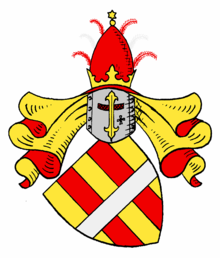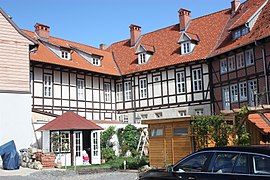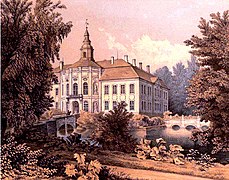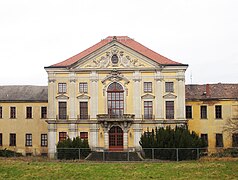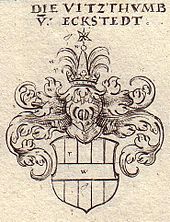Vitzthum (noble family)
Vitzthum is the name of an old and widely branched Thuringian noble family that first appeared in 1123 with Dietrich de Abbolde (von Apolda). Around 1300 it was placed by the governors of the Archbishops of Mainz in Erfurt. While the line to Vitzthum zu Roßla acted as robber barons in the 15th century, the counts line Vitzthum zu Eckstädt provided numerous statesmen and generals in Saxony from the 17th to the early 20th century.
history
The origin of the lords , barons and counts Vitzthum, also called von Vitzdom in old documents and writings , can be derived from the lords of Apolda , who probably had their ancestral home as early as the 11th century. The Apolda taverns may be of the same tribe as the Vargula taverns .
In the service of the Archbishop of Mainz, their descendants held the offices of gift giving as well as of the Vitztum ( vicedominus , representative of the prince) in Erfurt in the Electorate of Mainz (with the Eichsfeld territories). The Vitztum the archbishop had its administrative headquarters in the old governor's office to Erfurt . Since these court offices were hereditary at times, they were taken over in the family name of individual lines and passed on, even when the offices themselves were no longer hereditary and were finally no longer exercised by the family, because in 1342 the archbishop bought back the Vitztumsamt.
Splitting into lines

The Lords of Apolda first became the Apolda taverns , which died out towards the end of the 14th century. Before that, however, a line had separated from this in the middle of the 13th century, whose founder, Knight Berthold († around 1285), held the office of Erfurt Vice- Dominus and whose family seat was documented as Eckstedt near Erfurt from 1279 . From then on, this line was called Vitzthum von Eckstädt and built a new castle there in 1440.
There was a further subdivision at the beginning of the 14th century, when the knight Berthold († 1335) founded the branch Vitzthum zu Apolda and his brother Dietrich († 1337) founded the future branch Vitzthum zu Roßla . The Vitzthume also owned the castle in Burgscheidungen from 1334 to 1376 . From 1453 Brunnersdorf Castle in Bohemia was owned by Vitzthume until it was expropriated after the Battle of White Mountain in 1620.
The line from Vitzthum to Apolda
Apolda developed under the joint rule of the taverns and the Vitzthume in the second half of the 13th century to the city, whose rulers both lines remained until 1348. The Apolda taverns had their own mint in 1260; the coins were called Apoldsche Schenken . In 1348 the Apolda taverns renounced their rights to the city in favor of the Vitzthume. Soon afterwards, at the end of the 14th century, the line of taverns in the male line died out. The Vitzthume let themselves be feoffed at the same time by the Wettins with Apolda , whereby the overlordship practically passed to the Wettins. As a result of the division of Leipzig , Apolda came to the Ernestine Saxony in 1485 . However, the Archdiocese of Mainz maintained its claims as overlordship for several centuries and only gave it up in 1666. Anton Friedrich Vitzthum zu Apolda († 1631) was the last lord of the castle in the old family seat.
The line from Vitzthum to Tannroda
The castle in Niederroßla was sold to Knight Busso Vitzthum (d. 1384), descendant of the above-mentioned Dietrich, after the Knights of Roßla died out around 1375. His sons divided the inheritance around 1400. The branches Roßla and Tannroda emerged.
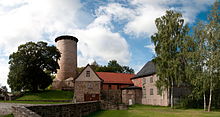
Busso's son Apel Vitzthum the Elder zu Tannroda († 1425) was the bailiff of Hohenberg. From 1407 to 1417 he was in the service of Frederick the Peaceful , Margrave of Meissen and Landgrave of Thuringia , but then moved to the court of Frederick the Arguable and Wilhelm the Rich of Saxony . In 1418 the family received Tannroda Castle with the town of Tannroda . His children were Apel Vitzthum the Younger zu Tannroda and Else, who was later married to Count Ernst von Gleichen . Around 1410 he took over Kriebstein Castle and in 1421 held the office of marshal, from 1422 he was upper marshal, from 1423 governor of Upper Lusatia . Apel the Younger also acquired Dornburg / Saale in 1462 , but was expelled in 1465. In the Saxon fratricidal war - he was a vassal of both parties - he knew how to play a relatively neutral role despite the negative role of his cousins from the Roßla line. The elector had regarded Apel's areas as hostile territory from 1446 onwards, but left him in possession of it after the end of the war while the cousins were driven out. In 1459 he sold Kriebstein together with the town of Waldheim , Hartha and all the villages. In 1465 Tannroda fell to the Count of Gleichen, who were related by marriage to Apel's sister Else .
The line from Vitzthum to Roßla
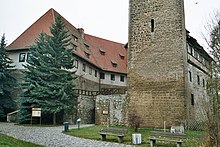
Apel Vitzthum the Elder of Roßla (* around 1400; † 1474), son of the knight Busso and the Eyle von Ileburg , was first mentioned in 1425. After his father's death in 1437 he was in the service of Elector Friedrich the Meek of Saxony and held the office of court master. In 1439 and 1440 he and his brothers Busso and Bernhard negotiated for the elector in the so-called Plauen Irrung . At the turn of the year 1444/1445, however, Apel left Friedrich's court in order to serve as a councilor to his brother, Duke Wilhelm . He also took up a position as court master with Wilhelm and played a highly inglorious role in the ensuing fratricidal war (1446-1451), which made him particularly hateful and in favor of the elector. As a result, Apel lost the rule of Lichtenwalde that belonged to him , which he had acquired in 1439 in exchange for Klöden , in 1447. 1450 enfeoffed Duke Wilhelm III. his councilors Apel, Busso and Bernhard Vitztum as well as Friedrich von Witzleben with the nearby Jena castle Gleißberg , for which they undertook to repair the deserted and dilapidated castle. The duke was probably a slave to them. Taking advantage of his trust, they had already accumulated wealth and property to the detriment of their master, so in 1447 Apel received the maintenance of Coburg and other properties. The Wachsenburg was also given to Roßla as a pledge in 1441 by Apel Vitzthum the Elder, who gradually developed from the ducal council to the notorious robber baron and became known as the “fire chief of Thuringia”. He is made responsible for the outbreak of the Saxon Fratricidal War from 1446 to 1451, in the course of which he lost the Roßla moated castle in 1447.
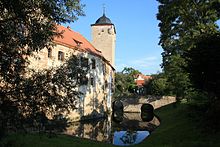

In 1446 the people of Erfurt entrusted him with the protection of their merchants in the Kapellendorf area and handed over the Kapellendorf moated castle and the associated office to him for a period of 21 years. In 1450, however, there was a break with Duke Wilhelm when he recognized the true role of this Vitzthume. Together with his brothers Busso and Bernhard, Apel Vizthum - who had fallen out of favor at the Saxon court - now turned against Landgrave Wilhelm III. of Thuringia and attacked Erfurt and other merchants several times. When an embassy from the Duke of Burgundy was on the way in October 1451 because of a planned marriage to the Saxon Elector Frederick II the Meek , it was attacked by the Vitzthum brothers, plundered and taken prisoner to Kapellendorf. The Saxon dukes, together with the cities of Erfurt , Sangerhausen , Mühlhausen and Nordhausen as well as the surrounding nobles, conquered the castles of Vitzthume in Kapellendorf, Wachsenburg, Kunitzburg, Dornburg, Leuchtenburg , Isserstedt , Camburg and others. After a four-week siege of the Wachsenburg, during which the defensive wall of the castle was undermined (by Mansfeld miners), Apel Vitzthum was finally forced to give up. In December 1451 the sloz Cappilndorf , in which part of the Burgundian councilors were imprisoned, was surrendered after an eight-week siege due to a lack of food and ammunition and the defenders were granted free withdrawal. In exchange for the Wachsenburg (it came into the possession of Duke Ernst the Pious of Gotha-Altenburg in 1640 ), the water castle Kapellendorf came back into the possession of the city of Erfurt in 1452. After the end of the fratricidal war, Apel Vitzthum was expelled from Roßla in 1452 and found a new job in Bohemia in 1453 as a councilor to the king there. There he also acquired the lordships of Klösterle (town with Klösterle Castle ) and Neuschönburg Castle (sometimes called "Schönburg").
In the following century Apel IV. Vitzthum ran a forging workshop on the Bohemian Neuschönburg . This was uncovered by imperial officials in 1530 and Apel IV, who was at a wedding in Vlašim at the time , fled to Electoral Saxony . He was punished in 1531 with the loss of his property and expelled from Bohemia by Ferdinand I.
The Vitzthum line from Eckstädt
In 1556 the Vitzthume von Eckstädt had the Eckstedter Castle , which they had renovated as a late Gothic building in 1440 and had owned since 1279, rebuilt in the Renaissance style; this building burned down before 1780 and was demolished in 1860. In 1564 Georg Vitzthum von Eckstädt also built the still preserved Kannawurf Castle , also in Renaissance style. The Kannawurf estate was owned by the Vitzthum from 1539 to 1685. The Quedlinburg monastery governor Christoph Vitzthum von Eckstedt (1552–1599) established the Vitzthum von Eckstedtschen Freihof there in 1597 .
Gottlob Christian Vitzthum von Eckstedt built the Baroque Jahmen Castle between 1715 and 1724 (which burned down in 1945); he was court marshal of Augustus the Strong , who stayed there several times for a few weeks. In 1711 Friedrich I. Vitzthum von Eckstädt (1675-1726), cabinet minister under Augustus the Strong, was elevated to the status of hereditary imperial count . He had Schönwölkau Palace , acquired by his father in 1659, splendidly redesigned and expanded in the Baroque style, and a park laid out. He had also inherited the small Krapenberg estate near Radebeul . His widow Rahel Charlotte, née Countess von Hoym , had the baroque palace built in Otterwisch between 1727 and 1730 , which passed to the Princely House of Schwarzburg-Sondershausen in 1779 . In the 18th century, the family owned the Großgestewitz manor in the Electorate of Saxony .
Kannawurf Castle , Thuringia
Vitzthum von Eckstedtscher Freihof in Quedlinburg, Saxony-Anhalt
former Jahmen Castle , Saxony
Kleinwölkau Castle in the municipality of Schönwölkau , Saxony
Otterwisch Castle , Saxony

The Castle Lichtenwalde fell in 1764 by Count Friedrich Carl von Watzdorf about his widow, Henriette Sophia, born Countess of Vitzthum Eckstädt to her family. From 1439 to 1447 this estate had briefly belonged to Apel Vitzthum the Elder of Roßla - now it became the headquarters of Count Vitzthum von Eckstädt, the only line of the family that is still flourishing today, until 1945. The baroque palace built in 1722 by the cabinet minister Count Christoph Heinrich von Watzdorf burned down in 1905 and burned to the ground; Count Friedrich Vitzthum von Eckstädt , however, had it rebuilt.
The Lichtenwalde, Schönwölkau, Reibitz and Sausedlitz estates were plundered and expropriated in 1945.
Good Sausedlitz
coat of arms
The family coat of arms of the Vitzthum von Eckstädt is emblazoned as follows :
“The center shield in gold with two red posts, covered with a silver bar. On the golden crowned pot helmet with red and gold covers, a red, arched pointed hat, decorated with a golden button and a gold star, and on the right and left with three curved cock feathers (red, silver, red). "
The line from Vitzthum to Apolda led a sloping branch with three apples hanging from it in the coat of arms and went out in 1631.
The Vitzthum zu Roßla line , which had the same coat of arms as the Apolda line, was divided into the Roßla and Tannroda branches at the beginning of the 15th century. While the Tannroda branch was extinguished in 1479, the Roßla branch mainly spread in Bohemia, but from 1623 also in Saxony and Alsace under the name Vitzthum von Egersberg to the present day.
Name bearer
to Apolda
- Christoph Vitzthum zu Apolda (* around 1483; † 1559)
- Moritz Vitzthum zu Apolda († 1578), son of Christoph
- Friedrich Vitzthum zu Apolda (* around 1521; † 1591), son of Christoph
- Wilhelm Friedrich Vitzthum zu Apolda († 1612), son of Friedrich
- Anton Friedrich Vitzthum zu Apolda († 1631), son of Wilhelm Friedrich, last lord of the castle of Apolda
The tombs of Christof and Friderich are in the Apoldaer Martinskirche .
to Tannroda
- Apel Vitzthum the Elder of Tannroda († 1425)
- Apel Vitzthum the Younger to Tannroda († 1475)
to Rossla
- Apel Vitzthum the Elder of Roßla († 1474), robber baron, "fire chief of Thuringia"
from Eckstedt / Eckstädt
-
Georg Vitzthum von Eckstedt (1551–1605), councilor and captain of Salza, Thamsbrück and Sachsenburg
- Johann Georg Vitzthum von Eckstedt (~ 1585–1641), canon of the collegiate churches in Halberstadt and Naumburg (Saale)
- Christian Vitzthum von Eckstedt (1592–1652), imperial colonel during the Thirty Years' War
- Dam Vitzthum von Eckstedt (1595–1638), Major General of the Electorate of Saxony
-
Christoph Vitzthum von Eckstedt (1552–1599) , Electoral Saxon colonel and governor
-
Christoph Vitzthum von Eckstedt (1594–1653) , Electoral Saxon colonel and governor
- Christian Vitzthum von Eckstädt († 1694), chamberlain of the Electorate of Saxony and district chief in Wittenberg
-
Christoph Vitzthum von Eckstädt (1633–1711), chamberlain and captain of the Electorate of Saxony, acquired the Wölkau estate in 1659
-
Friedrich Graf Vitzthum von Eckstädt (1675–1726), secret cabinet minister under Augustus the Strong and since 1711 imperial count
- Ludwig Siegfried Count Vitzthum von Eckstädt (1716–1777), electoral Saxon diplomat, envoy in Turin, St. Petersburg, Munich, Paris and Vienna
-
Christian Vitzthum von Eckstädt (1681–1738), royal Polish and electoral Saxon colonel
-
Johann Friedrich Graf Vitzthum von Eckstädt (1712–1786), Royal Polish and Electoral Saxon Lieutenant General of the Cavalry and Colonel of the Garde du Corps
- Friedrich August Graf Vitzthum von Eckstädt (1765–1803), chamberlain to the Elector of Saxony and chief tax collector
- Heinrich Vitzthum von Eckstädt (1770–1837), general director of the art academy a. the Kgl. Chapel (Court Theater) Dresden
-
Johann Friedrich Graf Vitzthum von Eckstädt (1712–1786), Royal Polish and Electoral Saxon Lieutenant General of the Cavalry and Colonel of the Garde du Corps
-
Friedrich Graf Vitzthum von Eckstädt (1675–1726), secret cabinet minister under Augustus the Strong and since 1711 imperial count
-
Christoph Vitzthum von Eckstedt (1594–1653) , Electoral Saxon colonel and governor
- Friedrich Wilhelm Vitzthum von Eckstedt (1578–1637), general of the cavalry in the Thirty Years War
- Georg Eberhard von Vitzthum († around 1638)
- Hans Wilhelm Vitzthum von Eckstädt (1604–1660), Chamber Councilor, Hofmeister and Drost of the County of Oldenburg
- Christoph Vitzthum von Eckstädt (1623–1688), councilor and governor of Upper Lusatia
- George Quirinus Vitzthum von Eckstädt (1663–1740), royal Polish and electoral Saxon chamberlain and chief accountant
- Albert Friedrich Vitzthum von Eckstädt (1797–1860), royal Saxon chamberlain
- Karl Friedrich Vitzthum von Eckstädt (1819–1895), Saxon and, after 1866, Austrian diplomat
- Julie Vitzthum von Eckstädt (1824–1910), Superior of the Diakonissenanstalt Dresden 1884–1909 (Source: Molwitz, Gustav: Anniversary report of the Evangelical Lutheran Diakonissenanstalt Dresden, Dresden 1894)
- Otto Heinrich Vitzthum von Eckstädt (1829–1917), Dr. theol. hc, Real Privy Councilor, Captain a. D., Honorary Citizen of Dresden (October 6, 1909)
- Otto Rudolf Vitzthum von Eckstädt (1831–1906), German administrative and court official
- Alexander Vitzthum von Eckstädt (1846–1916), Saxon infantry general
- Paul Graf Vitzthum von Eckstädt (1850–1911), Saxon general of the infantry and chief of the general staff of the Saxon army
- Friedrich Graf Vitzthum von Eckstädt (1855–1936), last Saxon Colonel Marshal, last President of the First Chamber of the Saxon State Parliament , last Majorate at Lichtenwalde Castle
- Carlotto Graf Vitzthum von Eckstädt (1857–1914), Saxon major general
- Christoph Johann Friedrich Graf Vitzthum von Eckstädt (1863–1944), 1909–1918 Saxon Interior and Foreign Minister
- Woldemar Vitzthum von Eckstädt (1863–1936), German lieutenant general
- Alexander Graf Vitzthum von Eckstädt (composer) (1874–1943), composer, colonel, holder of the military st. Order of Henry
- Hermann Vitzthum von Eckstädt (1876–1942), Saxon chamberlain, mite researcher
- Georg Vitzthum von Eckstädt (1880–1945), art historian
- Wolfgang Graf Vitzthum (* 1941), legal scholar, married to the ancient historian Hildegard Temporini-Countess Vitzthum (1939-2004)
See also
literature
- Julius Constantin Kronfeld: History and description of the factory and trading town of Apolda and its immediate surroundings. Apolda 1871.
- Richard Freiherr v. Mansberg: Hereditary team of Wettin countries. Dresden 1905 to 1908.
- Otto Eduard Schmidt : The castles Schönwölkau and Lichtenwalde and the Counts Vitzthum von Eckstädt , in: Communications of the Association of Saxon Homeland Security, XXII. Volume, 1933.
- Rudolf Graf Vitzthum von Eckstädt : Contributions to a Vitzthumschen family history. 1935.
- Revolutionary Letters 1848, ed.Rolf Weber, Leipzig 1973.
- Genealogical manual of the nobility , Volume 134, 2004, Adelslexikon .
Web links
- On the origin and name of Vitzthum
- The Vitzthum family in the Wildenfels castle archive
- The Vitzthum von Eckstädt family in the Wildenfels castle archive
Individual evidence
- ↑ a b Hermann Soltmann: Historically heraldic manual for the genealogical pocket book of the count's houses . Perthes, 1855 ( google.de [accessed on January 14, 2018]).
- ↑ Ulrich Völkel: Gastliches Thüringen , Arnstadt 1993, ISBN 3-929662-00-0
- ↑ http://www.klippstein.net/wsbg/wachsbg.htm
